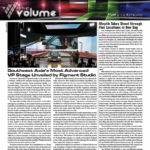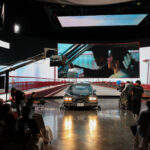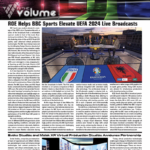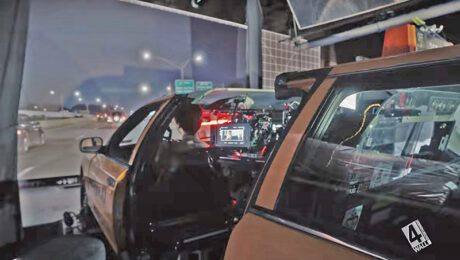
4Wall Entertainment played a vital role in supporting the production of the feature film Daddio, written and directed by Christy Hall and starring Dakota Johnson and Sean Penn. 4Wall built a virtual production studio to create a realistic backdrop of New York City streets, recreating a drive in a taxicab where the film takes place. This innovative approach enabled an efficient and visually stunning production, allowing the entire shoot to be completed in just 16 days.
Christy Hall, the visionary behind Daddio, expressed her amazement at the expertise and ingenuity of the 4Wall team in leveraging this technology, “I’ve done Q&As at Telluride and TIFF where audiences audibly gasped when I told them every single interior shot inside the cab was done on a soundstage,” she explained. “They couldn’t believe it looked so real. My film probably would not have been producible without this technology.”
Ben Danielowski, 4Wall VP of Special Projects, notes, “I think it’s important when bringing this technology to a production to make everybody feel comfortable. Although this is new, it’s not scary, it’s just another tool in the tool bag.” 4Wall VP of Special Projects Mathew Leland detailed the technical setup, commenting. “No DP shoots the same and they don’t use the same tools, and so oftentimes you’re dealing with a very bespoke process. What we often try to do is figure out what parts of our actual tools can get put in the hands of the people who already know how to create with them. That is one of the benefits of the Disguise media server platform. It is very well integrated with DMX, streaming ACN, Art-Net, all the different things that we use for lighting control. We have the lighting console, the traditional sort of programming route from the gaffer and the programmer, and then our color information that’s being mapped from the video. What ultimately happens is we can send color information to the lighting fixtures for some movement and variance in light as the cars are passing, then we can give them back control of the overall intensity. So it’s like the best of both worlds. Both have the control they want.”
Leland continues, “We knew we wanted a large hero wall, so we utilized a 52-foot LED wall to create the illusion of a traffic jam. From there, we added two roaming walls and reflective panels flown above the vehicle.” The project required innovative solutions to overcome the challenges of shooting in a confined space. Julian Sarmiento, Virtual Production Supervisor for Daddio says, “We knew from day one that the goal was to capture final picks. What we were seeing on the screens most likely was going to be pretty close to finals, and that’s actually where the setup from 4Wall really came together. Usually when we work in virtual production, the walls tend to be fixed. For this, it was a little different because the whole entire cell was modular. We no longer had to think about the environment or the sequence. We can focus just on the shot and we all, were constantly communicating, let’s move the wall, let’s increase the brightness, let’s change the content. So if you think about it, there’s about three or four things happening simultaneously, and that’s actually where magic happens, and this shows a perfect representation of what that looks like.”
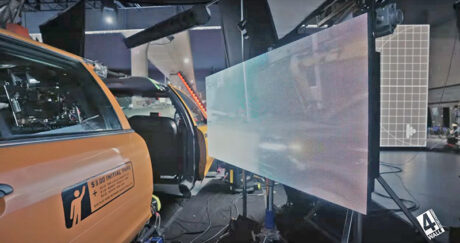
Technology Fueled Creativity
Essentially the use of VP technology added to the creative process. Hall points out from a directorial viewpoint, “This technology creates an immersive environment for the cast. When Sean was driving, he kept almost being afraid he was going to hit pedestrians because there were people crisscrossing and he was like, oh, right, it’s not real. Though the footage is real. We shot the drive on an array car with nine cameras and then projected the drive. So what you’re seeing is real. When Dakota looks out the window and cars are whizzing by she can actually see the street lamps and everything. They’re engaging with a real sense of time and place.”
Danielowski explains, “A large part of this production is also the reflections that we’re seeing in the car inside. We’ve got the divider and all the reflections that we’re seeing there. So whether it’s from our hero wall or from our ROE CB3 panels that are in the ceiling, we also are using them on rover stands, and that allows additional light to come and fill in as needed.” He continues, “It really allows us to utilize these surfaces as not just a light, not just a piece of gear, but as a part of the story. I think that’s the most important part of what we do, is we’re here at 4Wall to make everybody else’s life a little bit easier.” And on using plates captured by Plate Pros. “Choosing the driving plates felt like creating another character for the film,” he said. “Christy came to the table with a solid direction, and we were able to bring it to life with precision.”
Hall describes, “I’m at the monitor and I can see what it’s actually going to look like, not what I think it’s going to look like later, what it actually looks like in real time. So then I could work with 4Wall on even being extremely intentional about what you saw outside the windows. Phedon Papamichael, my incredible cinematographer, could also engage with the environment. So for example, we’re on Sean, a car whizzes by his window. As soon as the car passes, Phedon would hit him with some red light from the taillights of that car. So then suddenly we’re all playing in the sandbox together and we’re all able to offer more and more details to lend itself to the feeling of reality. I’ve had people say every single detail feel so intentional, and I’m like, I’m so glad you feel that way, because it is, it’s gut wrenchingly intentional.”
4Wall’s Wayne Romanowski, VP of LED Services, says, “This particular shoot, we found the Absen PL2.5 tile with 1/8th scan rate tile to be really useful. It’s high resolution at 200 pixels by 200 pixels per tile, helps in the tight confines to avoid moire on this camera. The other great thing about this tile, they’re driven by Brompton processing. Brompton has made huge strides in serving the needs of the film community and the specifics of virtual production.” 4Wall’s grasp of this technology and having the gear to capitalize on Brompton Technology’s Puretone and Dynacal, together with Absen PL2.5 tile with 1/8th scan rate, and Disguise’s process workflow ensured high accuracy in color at low light levels. “We use Disguise as our media server playback,” explained Leland. “What that does is gives us the entire canvas, so although we have these individual screens it’s all within one media server. It allows us to map however we want. Whether we want perspective sizing, we can really kind of change what’s being reprojected onto those screens. Having the Absen PL2.5 tile with 1/8th scan rate tiles running on the Brompton processing, that really allows us to get very accurate color on these screens. And at low light levels so that we can really capture the very specific drive from JFK airport to Hell’s Kitchen in the dark realistically.”
Traditional Non-Starter
Hall emphasized the importance of this technology for her film’s success. “Daddio proves that this technology offers flexibility to filmmakers, making the impossible possible. We had 16 days to shoot, with 13 of those days on a soundstage for the interior cab scenes. I had two incredible legendary actors, and I wanted to really protect their performances. It’s just the two of them. Not just in one scene, it’s the entire movie. So, I wanted to give them what they needed to really leave it all out on the field. That was really important. And it’s New York, on a very distinctive drive. New Yorkers know that drive and so it was really important that we got it right. The idea of throwing them in a cab with grip gear and cameras hanging off the side and trailering them, the continuity would have been a huge issue and we couldn’t predict weather.”
Danielowski agrees that the more traditional trailer shoot driving the route would have been a extremely difficult. “It’s not repeatable to do that. It’s not fun for anybody involved and to do that for 16 days would just be brutal. Inside the studio we have a controlled environment, the plates are the same each take, it’s repeatable. Additionally, you can’t drive half of a car down a highway and that’s what we’re doing in this film. We have half a car for our driver and half a car for our passenger. That allows the camera crew to get inside there with a little bit of space to work and do their magic.”
Hall concludes with how pleased she was with 4Wall. “What 4Wall gave us looked gorgeous but it was extremely cost effective. The end result is incredible, and I am so grateful for this new frontier in filmmaking.” Learn more about 4Wall Entertainment at www.4wall.com.
